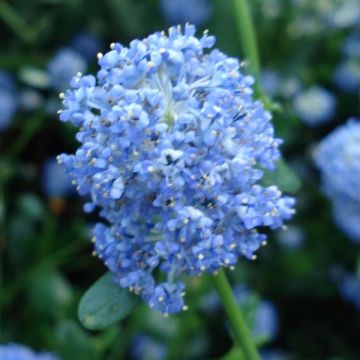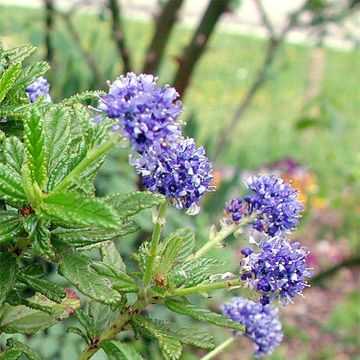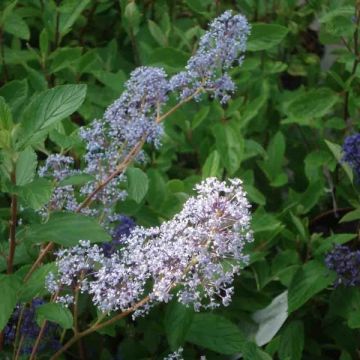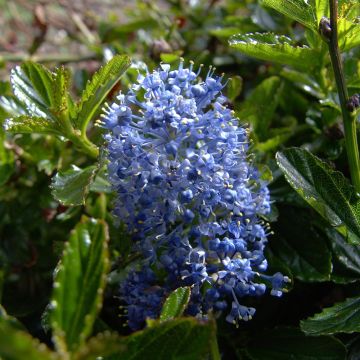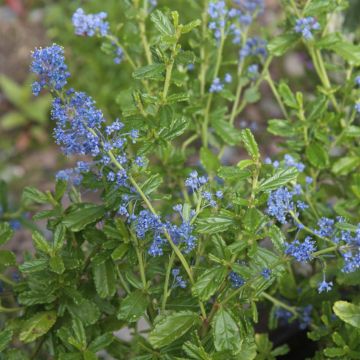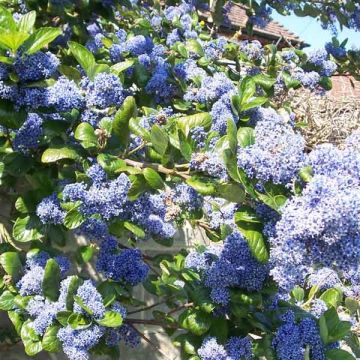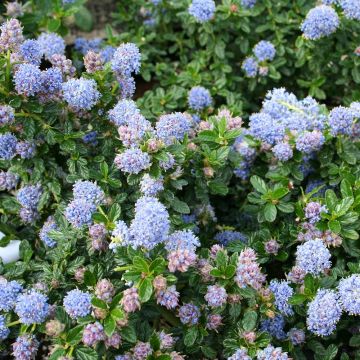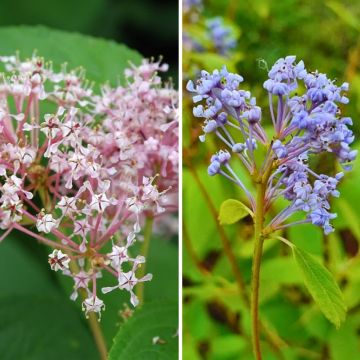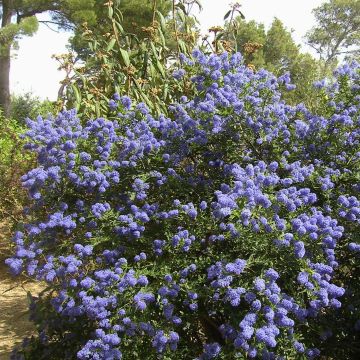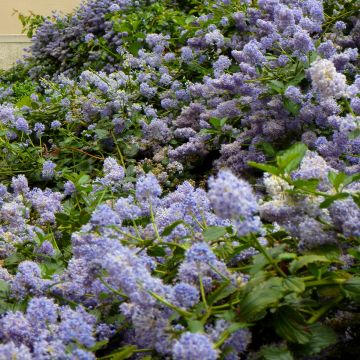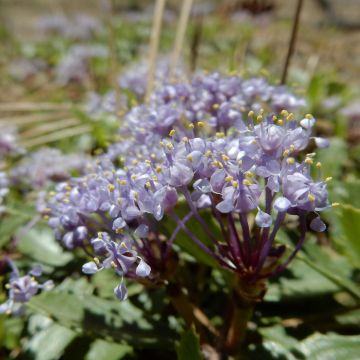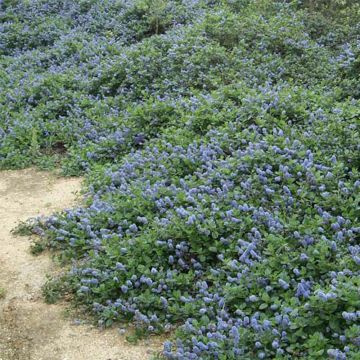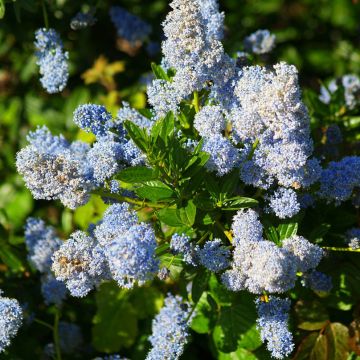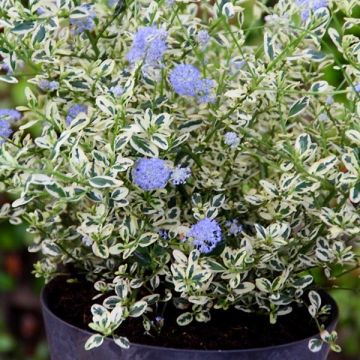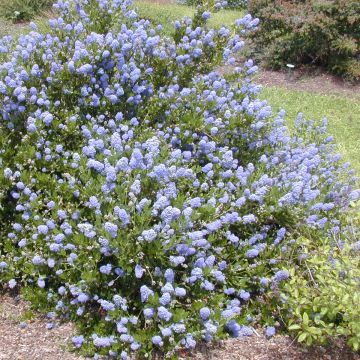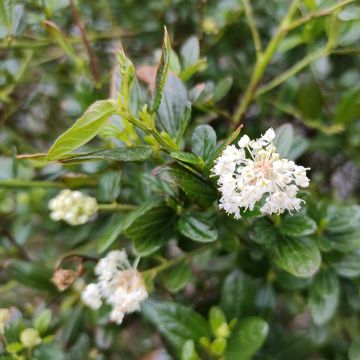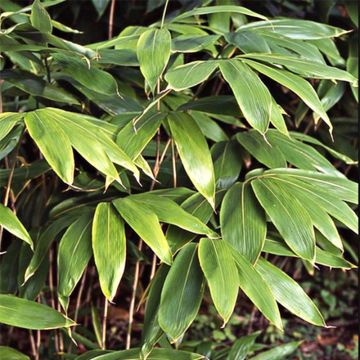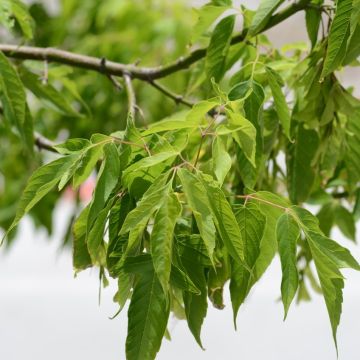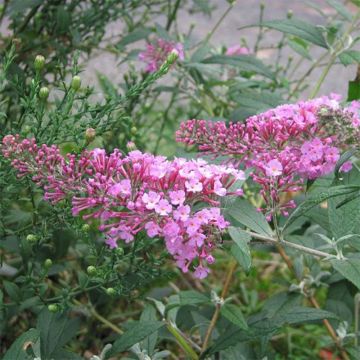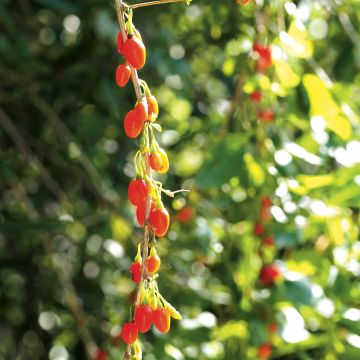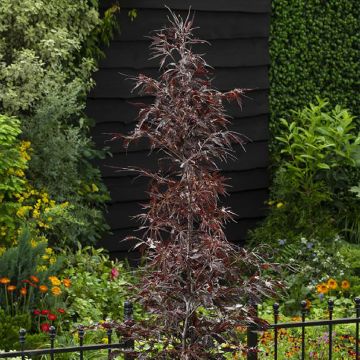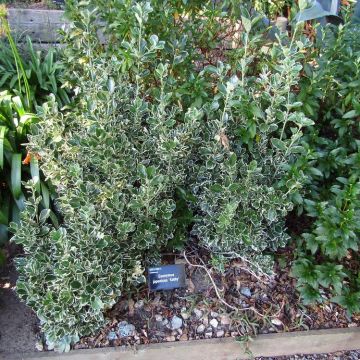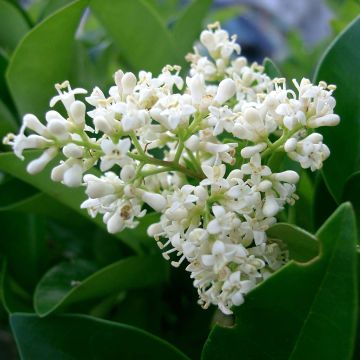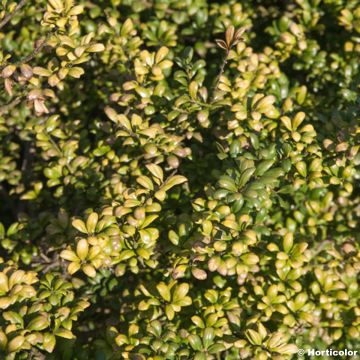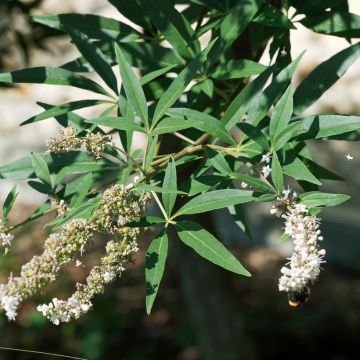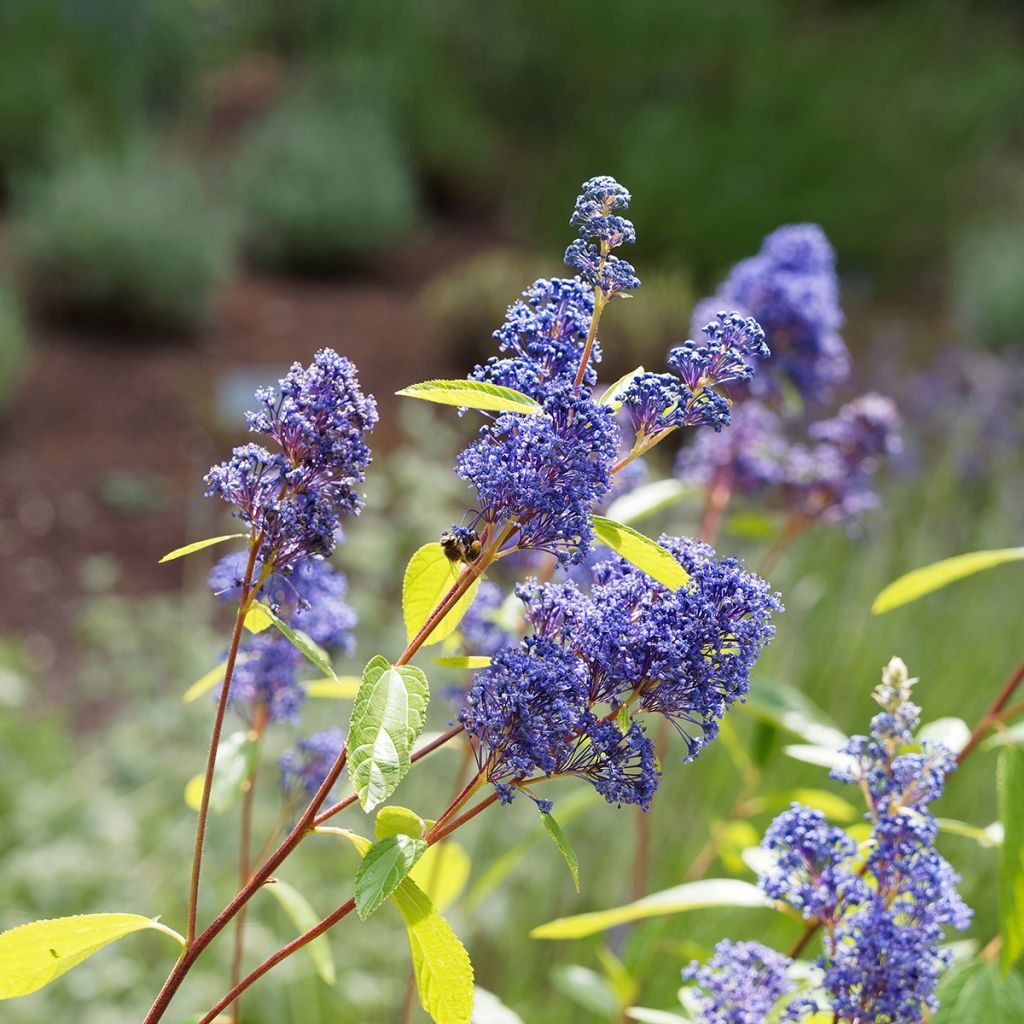

Ceanothus x delilianus Comtesse De Paris - Californian lilac
Ceanothus x delilianus Comtesse De Paris - Californian lilac
Ceanothus x delilianus Comtesse De Paris
Californian lilac
Why not try an alternative variety in stock?
View all →This plant carries a 24 months recovery warranty
More information
We guarantee the quality of our plants for a full growing cycle, and will replace at our expense any plant that fails to recover under normal climatic and planting conditions.
From €5.90 for pickup delivery and €6.90 for home delivery
Express home delivery from €8.90.
Does this plant fit my garden?
Set up your Plantfit profile →
Description
Ceanothus 'Comtesse de Paris' is a deciduous bush with a rounded habit that charms with its long and abundant summer flowering in indigo blue in elongated panicles. Honey-scented and brightly coloured flowers stand out against a background of bright green, finely toothed foliage. Deciduous Ceanothus are hardier than evergreen Ceanothus from California. They are low-maintenance bushes in terms of soil requirements, but less resistant to drought. The 'Comtesse de Paris' Ceanothus will make an excellent companion for roses in a shrub border or in an informal hedge, but it is also suitable for planting as a specimen plant.
Ceanothus (x) delilianus 'Comtesse de Paris' was obtained in France by the Minier nurseries in 1991, offered on the occasion of its jubilee to Madame la Comtesse. It is a hybrid between the varieties C. 'Henri Desfosse' and C. 'Topaze'. This cultivar does not appreciate excessively dry and/or calcareous soils, nor heavy, clay, and overly moist soils. This hybrid is quite hardy, tolerating brief frosts of around -15°C (5°F) once mature.
It is a bushy shrub with a slightly open habit, of fairly rapid growth, whose lifespan rarely exceeds twenty years. At maturity, it measures approximately 1.50 m (5ft) in all directions. Its branches bear leaves arranged alternately on the branches, oval in shape, measuring 8 to 10 cm (3 to 4in) long, and light green in colour. They generally fall in autumn, depending on the climate. The decorative interest of this Ceanothus lies in its beautiful and long flowering which begins in June-July and can continue in successive waves until October. It consists of light and upright panicles 10 to 15 cm (4 to 6in) long, located in the axils of the leaves and at the ends of the branches. Each panicle is composed of a multitude of tiny flowers with 5 petals in a deep violet-blue colour, with protruding stamens, slightly fragrant, nectar-bearing, and honey-scented. The flowers are followed by fruits which are woody capsules with 3 valves.
The Ceanothus 'Comtesse de Paris' is a compact shrub, well suited to small gardens and shrub borders. Its airy indigo blue flowering beautifully enhances that of roses and stands out nicely against golden and dark purple or black foliage. Combine it with several shrubs of different colours and shapes for a beautiful effect in a sunny border. Consider buddleias, lilacs, deutzias, and mock orange for example.
Tips: Prune your Ceanothus in early spring by cutting back the branches by half.
Report an error about the product description
Plant habit
Flowering
Foliage
Botanical data
Ceanothus
x delilianus
Comtesse De Paris
Rhamnaceae
Californian lilac
Cultivar or hybrid
Other Ceanothus
Planting and care
The 'Comtesse de Paris' Ceanothus can be planted all year round, except during frost and heatwaves, in well-drained soil, rich in humus, preferably non-calcareous, that stays slightly moist in the summer. It does not appreciate clay or waterlogged soils, nor dry and poor limestone soils in the summer. Choose a sunny location sheltered from prevailing winds. In heavy soil, plant it on a small mound. At planting, mix planting compost and possibly gravel into your garden soil. Apply organic amendment and water generously during the first two years. It is an easy plant to grow in many regions as long as the soil does not retain excessive moisture in winter and does not dry out too much in the summer. The Mediterranean region, which is very dry in the summer, is not suitable for it: evergreen Californian ceanothus will be much more comfortable there.
Planting period
Intended location
Care
This item has not been reviewed yet - be the first to leave a review about it.
Hedge shrubs
Haven't found what you were looking for?
Hardiness is the lowest winter temperature a plant can endure without suffering serious damage or even dying. However, hardiness is affected by location (a sheltered area, such as a patio), protection (winter cover) and soil type (hardiness is improved by well-drained soil).

Photo Sharing Terms & Conditions
In order to encourage gardeners to interact and share their experiences, Promesse de fleurs offers various media enabling content to be uploaded onto its Site - in particular via the ‘Photo sharing’ module.
The User agrees to refrain from:
- Posting any content that is illegal, prejudicial, insulting, racist, inciteful to hatred, revisionist, contrary to public decency, that infringes on privacy or on the privacy rights of third parties, in particular the publicity rights of persons and goods, intellectual property rights, or the right to privacy.
- Submitting content on behalf of a third party;
- Impersonate the identity of a third party and/or publish any personal information about a third party;
In general, the User undertakes to refrain from any unethical behaviour.
All Content (in particular text, comments, files, images, photos, videos, creative works, etc.), which may be subject to property or intellectual property rights, image or other private rights, shall remain the property of the User, subject to the limited rights granted by the terms of the licence granted by Promesse de fleurs as stated below. Users are at liberty to publish or not to publish such Content on the Site, notably via the ‘Photo Sharing’ facility, and accept that this Content shall be made public and freely accessible, notably on the Internet.
Users further acknowledge, undertake to have ,and guarantee that they hold all necessary rights and permissions to publish such material on the Site, in particular with regard to the legislation in force pertaining to any privacy, property, intellectual property, image, or contractual rights, or rights of any other nature. By publishing such Content on the Site, Users acknowledge accepting full liability as publishers of the Content within the meaning of the law, and grant Promesse de fleurs, free of charge, an inclusive, worldwide licence for the said Content for the entire duration of its publication, including all reproduction, representation, up/downloading, displaying, performing, transmission, and storage rights.
Users also grant permission for their name to be linked to the Content and accept that this link may not always be made available.
By engaging in posting material, Users consent to their Content becoming automatically accessible on the Internet, in particular on other sites and/or blogs and/or web pages of the Promesse de fleurs site, including in particular social pages and the Promesse de fleurs catalogue.
Users may secure the removal of entrusted content free of charge by issuing a simple request via our contact form.
The flowering period indicated on our website applies to countries and regions located in USDA zone 8 (France, the United Kingdom, Ireland, the Netherlands, etc.)
It will vary according to where you live:
- In zones 9 to 10 (Italy, Spain, Greece, etc.), flowering will occur about 2 to 4 weeks earlier.
- In zones 6 to 7 (Germany, Poland, Slovenia, and lower mountainous regions), flowering will be delayed by 2 to 3 weeks.
- In zone 5 (Central Europe, Scandinavia), blooming will be delayed by 3 to 5 weeks.
In temperate climates, pruning of spring-flowering shrubs (forsythia, spireas, etc.) should be done just after flowering.
Pruning of summer-flowering shrubs (Indian Lilac, Perovskia, etc.) can be done in winter or spring.
In cold regions as well as with frost-sensitive plants, avoid pruning too early when severe frosts may still occur.
The planting period indicated on our website applies to countries and regions located in USDA zone 8 (France, United Kingdom, Ireland, Netherlands).
It will vary according to where you live:
- In Mediterranean zones (Marseille, Madrid, Milan, etc.), autumn and winter are the best planting periods.
- In continental zones (Strasbourg, Munich, Vienna, etc.), delay planting by 2 to 3 weeks in spring and bring it forward by 2 to 4 weeks in autumn.
- In mountainous regions (the Alps, Pyrenees, Carpathians, etc.), it is best to plant in late spring (May-June) or late summer (August-September).
The harvesting period indicated on our website applies to countries and regions in USDA zone 8 (France, England, Ireland, the Netherlands).
In colder areas (Scandinavia, Poland, Austria...) fruit and vegetable harvests are likely to be delayed by 3-4 weeks.
In warmer areas (Italy, Spain, Greece, etc.), harvesting will probably take place earlier, depending on weather conditions.
The sowing periods indicated on our website apply to countries and regions within USDA Zone 8 (France, UK, Ireland, Netherlands).
In colder areas (Scandinavia, Poland, Austria...), delay any outdoor sowing by 3-4 weeks, or sow under glass.
In warmer climes (Italy, Spain, Greece, etc.), bring outdoor sowing forward by a few weeks.

































